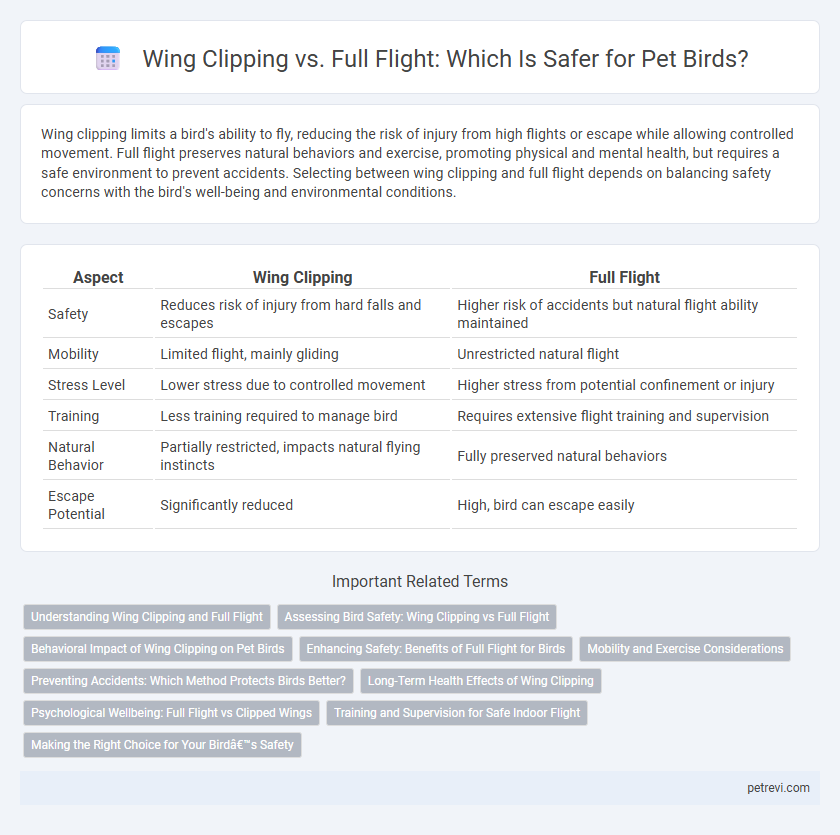Wing clipping limits a bird's ability to fly, reducing the risk of injury from high flights or escape while allowing controlled movement. Full flight preserves natural behaviors and exercise, promoting physical and mental health, but requires a safe environment to prevent accidents. Selecting between wing clipping and full flight depends on balancing safety concerns with the bird's well-being and environmental conditions.
Table of Comparison
| Aspect | Wing Clipping | Full Flight |
|---|---|---|
| Safety | Reduces risk of injury from hard falls and escapes | Higher risk of accidents but natural flight ability maintained |
| Mobility | Limited flight, mainly gliding | Unrestricted natural flight |
| Stress Level | Lower stress due to controlled movement | Higher stress from potential confinement or injury |
| Training | Less training required to manage bird | Requires extensive flight training and supervision |
| Natural Behavior | Partially restricted, impacts natural flying instincts | Fully preserved natural behaviors |
| Escape Potential | Significantly reduced | High, bird can escape easily |
Understanding Wing Clipping and Full Flight
Wing clipping involves trimming a bird's primary flight feathers to limit its ability to fly, reducing risks of injury from uncontrolled flights or escapes. Full flight allows birds to maintain natural flying abilities, promoting physical exercise and mental stimulation but requires enhanced environmental safety measures. Understanding the balance between wing clipping and full flight helps bird owners optimize safety while supporting avian health and well-being.
Assessing Bird Safety: Wing Clipping vs Full Flight
Assessing bird safety involves comparing wing clipping and full flight to reduce injury risks and escape hazards. Wing clipping restricts flight capabilities, minimizing damage from collisions but can impact natural behaviors and mental health. Full flight preserves natural instincts and exercise, requiring enhanced environmental safety measures to prevent accidents.
Behavioral Impact of Wing Clipping on Pet Birds
Wing clipping in pet birds significantly restricts their natural flight abilities, which can lead to reduced physical activity and altered behavioral patterns such as increased aggression or feather plucking. Full flight enables birds to engage in essential behaviors like exercise, exploration, and social interaction, contributing positively to their mental and physical well-being. Behavioral changes observed in wing-clipped birds highlight the importance of considering flight restrictions' impact on overall bird safety and welfare.
Enhancing Safety: Benefits of Full Flight for Birds
Full flight allows birds to evade predators and navigate hazards, significantly reducing injury risks compared to wing clipping, which restricts their mobility. Maintaining full wing functionality supports natural behaviors crucial for mental and physical health, enhancing overall wellbeing. This mobility also enables birds to escape unsafe environments promptly, promoting long-term survival and safety.
Mobility and Exercise Considerations
Wing clipping limits a bird's flight ability, reducing mobility but preventing accidents and escapes, essential for safety in confined environments. Full flight maintains natural exercise routines, supporting muscle development, cardiovascular health, and mental stimulation, but increases the risk of injury from collisions or escapes. Evaluating a bird's environment and lifestyle helps balance safety concerns with the need for physical activity and mobility.
Preventing Accidents: Which Method Protects Birds Better?
Wing clipping limits a bird's flight ability, reducing risks of high falls and collisions within indoor environments, making it a common safety precaution for pet birds. Full flight allows birds to maintain natural exercise and escape from potential dangers, but increases the chance of indoor accidents like crashing into windows or flying into hazardous areas. Studies of avian behavior indicate that controlled flight with proper training and environmental adaptations can strike a balance between safety and wellbeing, potentially offering better long-term protection than wing clipping alone.
Long-Term Health Effects of Wing Clipping
Wing clipping restricts a bird's ability to fly, which can lead to muscle atrophy and obesity due to reduced exercise, negatively affecting long-term health. Full flight allows birds to maintain natural muscle tone and cardiovascular fitness, promoting overall well-being and mental stimulation. However, full flight requires a safe environment to prevent injuries, highlighting the importance of balanced care for bird safety and health.
Psychological Wellbeing: Full Flight vs Clipped Wings
Full flight preserves a bird's natural behavior, enhancing its psychological wellbeing by allowing freedom of movement and exploration, which reduces stress and anxiety. Wing clipping restricts flight, potentially leading to frustration, boredom, and behavioral issues such as feather plucking or aggression due to limited environmental interaction. Maintaining full flight supports mental stimulation and overall emotional health essential for a bird's quality of life.
Training and Supervision for Safe Indoor Flight
Wing clipping limits a bird's flight ability, reducing the risk of injury indoors while requiring consistent supervision to prevent escape or accidents. Full flight allows natural movement and exercise but demands rigorous training and vigilant monitoring to ensure safety and prevent collisions with windows or household objects. Effective bird training emphasizes recall commands and safe flight zones to balance freedom with protection during indoor flight.
Making the Right Choice for Your Bird’s Safety
Choosing between wing clipping and full flight for bird safety depends on balancing freedom and protection. Wing clipping limits mobility, reducing risks of injury or escape, but can inhibit natural behaviors and exercise. Allowing full flight encourages physical health and mental stimulation while requiring a secure environment to prevent accidents and predation.
Wing clipping vs Full flight for Bird safety Infographic

 petrevi.com
petrevi.com